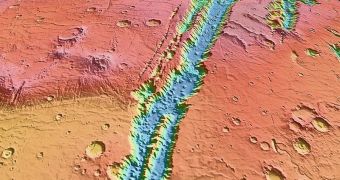A team of investigators from the California Institute of Technology (Caltech) argues in a study that megafloods like the ones that occurred on Earth in its recent past may hold the key to explaining the presence of canyons on Mars. This has been puzzling geologists for quite some time now.
The conclusion was derived from a study of a gorge in Idaho that was apparently carved around 50,000 years ago, during a megaflood event. The research group believes that the characteristics of this gorge are similar to those of structures found on the surface of the Red Planet, and whose structure and origins have yet to be clearly identified.
Canyons are generally formed as water flows over a particular area and erodes the soft rock underneath. Over time, any river that is large enough can dig up massive trenches in the surface of a planet, such as the Grand Canyon on Earth and Valles Marineris on Mars.
The shapes of canyons can be used to gain a deeper understanding of the water flows that produces them. In a sense, these landscape features can provide a historic account of the distant past, enabling geologists to reconstruct the landscape that permeated various worlds long ago, Space reports.
“Landforms on Earth and Mars record information about past environments and events that predate the historical record. As geologists, we are always seeking new insight to read this record to better understand our planet and its potential for change,” says Caltech geologist Michael Lamb.
The expert is also the lead author of a new paper detailing the study, which is published in the December 16 online issue of the esteemed journal Proceedings of the National Academy of Sciences.
Studies of the Red Planet have revealed that so-called amphitheater-headed canyons abound on its surface. The heads of such canyons look like amphitheaters when observed from above, and feature vertical walls. Niagara Falls here on Earth would be a good example of this shape.
Interestingly, these canyons are relatively rare on the surface of Earth, but they can be found in abundance on Mars. According to the new study, upwelling springs did not form amphitheater-headed canyons via a slow and steady process of erosion, as previously suggested.
Instead, massive floods could have been responsible. According to the team's calculations, the flood waters were around 9 meters (30 feet) deep, and flowed at a rate of 1.25 million liters (330,000 gallons) per second. How such a flow could be achieved on the surface of Mars still remains a mystery.
“Using Earth as our guide, the early history of Mars surface environments, including the amounts and duration of flowing surface water, is waiting to be discovered through careful analysis of the landforms and sedimentary deposits on the Red Planet. It's an exciting time to be a geologist,” Lamb concludes.

 14 DAY TRIAL //
14 DAY TRIAL //